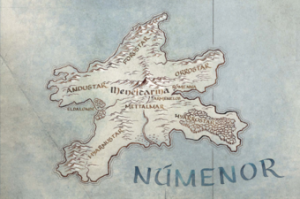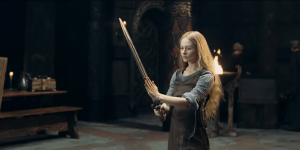POTENTIAL SPOILERS FOR THE RINGS OF POWER SEASON TWO AHEAD!
Specifically targeting those viewers who couldn’t make it through The Rings Of Power‘s slow-paced first season, the teaser trailer for the epic fantasy series’ upcoming second season promises high-octane action sequences, thrilling drama, and stunning visuals that the most expensive show in the history of television has to be able to deliver consistently (and probably shouldn’t need to convince anyone that it can). The drastic shift in tone is due at least in part to the fact that, in-universe, the character of Sauron is out in the open now and The Rings Of Power can finally employ him in its marketing campaign, instead of having to conceal their charismatic antagonist behind various red-herrings.
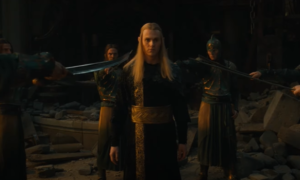
Charlie Vickers returns as Sauron’s “fair form”, casting off the drab and filthy rags he wore while disguised as the human Halbrand throughout season one, donning new and more richly-embroidered garments of black and gold, with long golden-brown hair and pointed ears to fit the part of an Elf. There are several shots and lines of dialogue in the trailer that seem to indicate the writers are trying to follow the story as sketched out by J.R.R. Tolkien in The Silmarillion, in which Sauron posed as an Elven emissary from Valinor named Annatar to gain access to the powerful forges of Eregion and seduce the great jewel-smith Celebrimbor. In The Rings Of Power‘s non-canonical version of events, of course, Sauron (as Halbrand) already weaseled his way into Eregion and assisted Celebrimbor in making the Three Rings before Galadriel made him leave, so unless Elves are just totally face-blind, it’s hard to believe that the new hairstyle and fit will fool everyone in Eregion. Even if they don’t realize he’s Sauron (because Galadriel kinda left that part out when she told everyone that Halbrand was gone), surely they’d question how Halbrand turned into an Elf overnight?
Or maybe not. There’s a shot in the trailer of Celebrimbor, in his forge, shielding his eyes as a figure strides toward him through parting clouds, silhouetted against a bright white light, which I initially interpreted as the sunlight breaking through a hole in the wall, with the clouds being the smoke of war. But rewatching the footage, I feel that the imagery is heavily evocative of how The Rings Of Power depicted the light of Valinor, and of the cloud-wall surrounding the Undying Lands to the Uttermost West that rolls back to allow the grey ships of the Elves through. I would go so far as to bet that this scene is from the very first episode of the second season, and demonstrates how Sauron will get away with his ruse, by appearing only to Celebrimbor as an angel (for lack of a better word, and because that’s essentially what Sauron is, or was, before his fall). Remember, Celebrimbor was quite taken by Halbrand, and benefited greatly from their brief partnership, so Sauron may choose to keep the man’s face specifically for that reason. Maybe he doesn’t even have to set foot in Eregion to continue his corruption of Celebrimbor. Imagine your guardian angel secretly trying to lead you to your doom, now that’s the kind of dirty trick at which Sauron excels.
I am most intrigued at what Amazon apparently doesn’t consider a spoiler – you’d think that the shot, near the end of the trailer, of Sauron standing amidst the ruins of Celebrimbor’s forge, still wearing his fair form, but encircled by sword-wielding Elves in armor (including Celebrimbor himself, who appears to be missing his left hand), would be giving away a major plot-point, but if it’s not, that means that the writers might still have a few tricks up their sleeves, and maybe all is not as it seems. What is plain to see, however, is that the kingdom of Eregion is under siege by Sauron’s forces, and the aforementioned shot, as well as one of Celebrimbor frantically dumping rings (presumably the lesser Rings of Power) into the flames where they were made, strongly implies that their defenses will not hold.
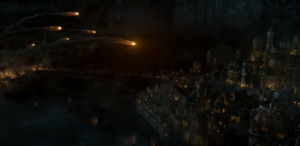
Before then, we can expect to see Eregion’s craftspeople reach the pinnacle of their creativity and innovation under Celebrimbor’s guidance (and Sauron’s instructions, whispered in his ear), with two more sets of great Rings, seven for the Dwarf-lords in their halls of stone and nine for mortal Men doomed to die, forged alongside the Three, which are safely – and secretly – situated on the hands of King Gil-galad of Lindon, the Lady Galadriel, and Círdan the Shipwright (the latter a character we have not met in any prior adaptation of Tolkien’s works). We catch a quick glimpse of Peter Mullan’s King Durin III holding what is very likely the Ring given to his clan, inset with a rough blue gemstone. No sign of the Nine, that I could find anywhere in the trailer or in the accompanying behind-the-scenes feature released on YouTube, but it may be that Sauron will come into possession of a great many Rings and then begin distributing them amongst Men in the third season.
Still geographically removed from Middle-earth’s problems but not far enough to protect them from the fallout, Númenor, the greatest kingdom of Men in Middle-earth, is seen in the throes of religious strife following the death of the old king and the return of his daughter Míriel from a crushing defeat on the battlefields of the Southlands with wounds to both her body and her pride. Míriel remains faithful to the traditions followed by generations of Númenórean monarchs before her, but there are many, even in her own court, who believe that the time has come to shrug off the burden of their old oaths to the Elves and the gods in Valinor. An Eagle of the West, regarded by the Faithful as heralds of the god Manwë, alights in the Court of the Kings, and Pharazôn, Míriel’s advisor, approaches the bird with sword unsheathed. Míriel is tortured by visions of a leviathan, some Lovecraftian horror with the face of a goblin shark and the body of a squid, rising up from the depths to swallow her and the island nation whole (I was deeply disappointed with the sea-monster in season one, so this, whether it’s a real creature or merely a metaphor for Númenor’s impending demise, is the shot that got me most excited for the new season).
Meanwhile, on the other side of the map, Elanor Brandyfoot and the Stranger trek through the lands of Rhûn, trying to piece together a more accurate picture of where the Stranger came from and where he’s supposed to be going by following the trail of the Mystics, the only three people in Middle-earth who knew who he was. Though the Stranger incinerated their flesh-and-blood bodies in the first season using his magic, and they evaporated into a swarm of butterflies, it seems we’re not done with the Mystics just yet, or perhaps, with the organization of which they were a part. A woman with bloody hands, wearing similar clothes to the Mystics we’ve seen already, is seen standing in a temple with sandstone pillars, while butterflies swirl around her. Despite all the evidence to the contrary, I remain convinced that the Stranger is not Gandalf but one of the two enigmatic Blue Wizards, and that the Mystics are disciples of the other, who arrived in Middle-earth long before him. I say this because one of the very few descriptions Tolkien left behind of the Blue Wizards mentions that they founded “secret cults and magic traditions” in the East, which aligns so perfectly with everything we know about these Mystics, it’s aggravating to think that there are actually other alternatives.
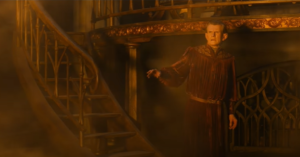
Something fascinating that The Rings Of Power is doing (and not getting enough credit for) is diving into these corners of Tolkien’s lore that no one else has dared to touch, and expanding the general audience’s understanding of what Middle-earth can be. Don’t get me wrong, the writers have made their fair share of choices and changes, some of which have rubbed me the wrong way, but it’s that exact willingness to think outside the box that makes The Rings Of Power so enjoyable for me, because I genuinely never know what to expect. A wizard falling out of the sky into a nomadic tribe of proto-Hobbits, hints of romantic tension between Galadriel and Sauron, apocryphal origin stories for mithril, and now the rumor around town is that Tom Bombadil could show up in season two – yes, that Tom Bombadil, the same singing, dancing, bright yellow boot-wearing character who’s been cut out of every previous film adaptation of The Lord Of The Rings because he would have been too bizarre and random for people’s minds to process. Whether they can pull that off is anyone’s guess, but you’ve got to respect that a show this expensive, whose creators have every incentive to stick to played-out stories, is still taking the path least traveled and not once apologizing for it.
Trailer Rating: 9/10




